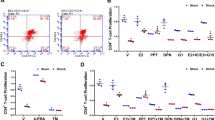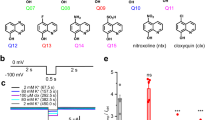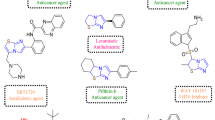Abstract
Aim:
Atazanavir (ATV) is a HIV-1 protease inhibitor for the treatment of AIDS patients, which is recently reported to provoke excessive prolongation of the QT interval and torsades de pointes (TdP). In order to elucidate its arrhythmogenic mechanisms, we investigated the effects of ATV on the hERG K+ channels expressed in HEK293 cells.
Methods:
hERG K+ currents were detected using whole-cell patch clamp recording in HEK293 cells transfected with EGFP-hERG plasmids. The expression of hERG protein was measured with Western blotting. Two mutants (Y652A and F656C) were constructed in the S6 domain within the inner helices of hERG K+ channels that were responsible for binding of various drugs. The trafficking of hERG protein was studied with confocal microscopy.
Results:
Application of ATV (0.01–30 μmol/L) concentration-dependently decreased hERG K+ currents with an IC50 of 5.7±1.8 μmol/L. ATV (10 μmol/L) did not affect the activation and steady-state inactivation of hERG K+ currents. Compared with the wild type hERG K+ channels, both Y652A and F656C mutants significantly reduced the inhibition of ATV on hERG K+ currents. Overnight treatment with ATV (0.1–30 μmol/L) concentration-dependently reduced the amount of fully glycosylated 155 kDa hERG protein without significantly affecting the core-glycosylated 135 kDa hERG protein in the cells expressing the WT-hERG protein. Confocal microscopy studies confirmed that overnight treatment with ATV obstructed the trafficking of hERG protein to the cell membrane.
Conclusion:
ATV directly blocks hERG K+ channels via binding to the residues Y652 and F656 in the S6 domain, and indirectly obstructs the transport of the hERG protein to the cell membrane.
Similar content being viewed by others
Log in or create a free account to read this content
Gain free access to this article, as well as selected content from this journal and more on nature.com
or
References
Rivas P, Morello J, Garrido C, Rodriguez-Novoa S, Soriano V . Role of atazanavir in the treatment of HIV infection. Ther Clin Risk Manag 2009; 5: 99–116.
Reyataz product information [homepage on the Internet]. Bristol-Myers Squibb Company; Princeton, NJ 08543, USA: [cited 8 March 2014]. Available from: http://packageinserts.bms.com/pi/pi_reyataz.pdf.
Bristol-Myers Squibb Company. BMS-232632, atazanavir briefing document, May 2003. [homepage on the Internet]. [cited 8 March 2014]. Available from: http://www.fda.gov/ohrms/dockets/ac/03/briefing/3950B1_01_BristolMyersSquibb-Atazanavir.pdf
Girgis I, Gualberti J, Langan L, Malek S, Mustaciuolo V, Costantino T, et al. A prospective study of the effect of IV pentamidine therapy on ventricular arrhythmias and QTc prolongation in HIV-infected patients. Chest 1997; 112: 646–53.
Castillo R, Pedalino RP, El-Sherif N, Turitto G . Efavirenz-associated QT prolongation and Torsade de Pointes arrhythmia. Ann Pharmacother 2002; 36: 1006–8.
Saidi AS, Moodie DS . Garson A Jr, Lipshultz SE, Kaplan S, Lai WW, et al. Electrocardiography and 24-h electrocardiographic ambulatory recording (Holter monitor) studies in children infected with human immunodeficiency virus type 1. The Pediatric Pulmonary and Cardiac Complications of Vertically Transmitted HIV-1 Infection Study Group. Pediatr Cardiol 2000; 21: 189–96.
Vallejo Camazon N, Rodriguez Pardo D, Sanchez Hidalgo A, Tornos Mas MP, Ribera E, Soler Soler J . Ventricular tachycardia and long QT associated with clarithromycin administration in a patient with HIV infection. Rev Esp Cardiol 2002; 55: 878–81.
Ly T, Ruiz ME . Prolonged QT interval and torsades de pointes associated with atazanavir therapy. Clin Infect Dis 2007; 44: e67–8.
Gallagher DP, Kieran J, Sheehan G, Lambert J, Mahon N, Mallon PW . Ritonavir-boosted atazanavir, methadone, and ventricular tachycardia: 2 case reports. Clin Infect Dis 2008; 47: e36–8.
Santimaleeworagun W, Pattharachayakul S, Chusri S, Chayagul P . Atazanavir induced first degree atrioventricular block and ventricular tachycardia: a case report. J Med Assoc Thai 2013; 96: 501–3.
Busti AJ, Tsikouris JP, Peeters MJ, Das SR, Canham RM, Abdullah SM, et al. A prospective evaluation of the effect of atazanavir on the QTc interval and QTc dispersion in HIV-positive patients. HIV Med 2006; 7: 317–22.
Charbit B, Rosier A, Bollens D, Boccara F, Boelle PY, Koubaa A, et al. Relationship between HIV protease inhibitors and QTc interval duration in HIV-infected patients: a cross-sectional study. Br J Clin Pharmacol 2009; 67: 76–82.
Redfern WS, Carlsson L, Davis AS, Lynch WG, MacKenzie I, Palethorpe S, et al. Relationships between preclinical cardiac electrophysiology, clinical QT interval prolongation and torsade de pointes for a broad range of drugs: evidence for a provisional safety margin in drug development. Cardiovasc Res 2003; 58: 32–45.
Anson BD, Weaver JG, Ackerman MJ, Akinsete O, Henry K, January CT, et al. Blockade of HERG channels by HIV protease inhibitors. Lancet 2005; 365: 682–6.
Han S, Zhang Y, Chen Q, Duan Y, Zheng T, Hu X, et al. Fluconazole inhibits hERG K(+) channel by direct block and disruption of protein trafficking. Eur J Pharmacol 2011; 650: 138–44.
Park SJ, Kim KS, Kim EJ . Blockade of HERG K+ channel by an antihistamine drug brompheniramine requires the channel binding within the S6 residue Y652 and F656. J Appl Toxicol 2008; 28: 104–11.
Guo J, Han SN, Liu JX, Zhang XM, Hu ZS, Shi J, et al. The action of a novel fluoroquinolone antibiotic agent antofloxacin hydrochloride on human-ether-a-go-go-related gene potassium channel. Basic Clin Pharmacol Toxicol 2010; 107: 643–9.
Hu HN, Zhou PZ, Chen F, Li M, Nan FJ, Gao ZB . Discovery of a retigabine derivative that inhibits KCNQ2 potassium channels. Acta Pharmacol Sin 2013; 34: 1359–66.
Mitcheson JS, Chen J, Lin M, Culberson C, Sanguinetti MC . A structural basis for drug-induced long QT syndrome. Proc Natl Acad Sci USA 2000; 97: 12329–33.
Wang L, Wible BA, Wan X, Ficker E . Cardiac glycosides as novel inhibitors of human ether-a-go-go-related gene channel trafficking. J Pharmacol Exp Ther 2007; 320: 525–34.
Kuryshev YA, Ficker E, Wang L, Hawryluk P, Dennis AT, Wible BA, et al. Pentamidine-induced long QT syndrome and block of hERG trafficking. J Pharmacol Exp Ther 2005; 312: 316–23.
Perry M, de Groot MJ, Helliwell R, Leishman D, Tristani-Firouzi M, Sanguinetti MC, et al. Structural determinants of HERG channel block by clofilium and ibutilide. Mol Pharmacol 2004; 66: 240–9.
Rodriguez-Menchaca A, Ferrer-Villada T, Lara J, Fernandez D, Navarro-Polanco RA, Sanchez-Chapula JA . Block of HERG channels by berberine: mechanisms of voltage- and state-dependence probed with site-directed mutant channels. J Cardiovasc Pharmacol 2006; 47: 21–9.
Witchel HJ, Dempsey CE, Sessions RB, Perry M, Milnes JT, Hancox JC, et al. The low-potency, voltage-dependent HERG blocker propafenone-molecular determinants and drug trapping. Mol Pharmacol 2004; 66: 1201–12.
Rajamani S, Eckhardt LL, Valdivia CR, Klemens CA, Gillman BM, Anderson CL, et al. Drug-induced long QT syndrome: hERG K+ channel block and disruption of protein trafficking by fluoxetine and norfluoxetine. Br J Pharmacol 2006; 149: 481–9.
Sun H, Liu X, Xiong Q, Shikano S, Li M . Chronic inhibition of cardiac Kir2.1 and HERG potassium channels by celastrol with dual effects on both ion conductivity and protein trafficking. J Biol Chem 2006; 281: 5877–84.
Chae YJ, Jeon JH, Lee HJ, Kim IB, Choi JS, Sung KW, et al. Escitalopram block of hERG potassium channels. Naunyn Schmiedebergs Arch Pharmacol 2014; 387: 23–32.
Staudacher I, Wang L, Wan X, Obers S, Wenzel W, Tristram F, et al. hERG K+ channel-associated cardiac effects of the antidepressant drug desipramine. Naunyn Schmiedebergs Arch Pharmacol 2011; 383: 119–39.
Zhang KP, Yang BF, Li BX . Translational toxicology and rescue strategies of the hERG channel dysfunction: biochemical and molecular mechanistic aspects. Acta Pharmacol Sin 2014; 35: 1473–84.
Holmberg SD, Moorman AC, Williamson JM, Tong TC, Ward DJ, Wood KC, et al. Protease inhibitors and cardiovascular outcomes in patients with HIV-1. Lancet 2002; 360: 1747–8.
Friis-Moller N, Sabin CA, Weber R, d'Arminio Monforte A, El-Sadr WM, Reiss P, et al. Combination antiretroviral therapy and the risk of myocardial infarction. N Engl J Med 2003; 349: 1993–2003.
Roden DM . Drug-induced prolongation of the QT interval. N Engl J Med 2004; 350: 1013–22.
Soliman EZ, Lundgren JD, Roediger MP, Duprez DA, Temesgen Z, Bickel M, et al. Boosted protease inhibitors and the electrocardiographic measures of QT and PR durations. AIDS 2011; 25: 367–77.
Acknowledgements
We thank Dr Gail A ROBERTSON for providing us the plasmids of pcDNA3-hERG. This work was supported by the National Natural Science Foundation of China (No 81200138) and the Key Technologies R&D Program of Henan Province (No 92102310225).
Author information
Authors and Affiliations
Corresponding author
Rights and permissions
About this article
Cite this article
Han, Sn., Sun, Xy., Zhang, Z. et al. The protease inhibitor atazanavir blocks hERG K+ channels expressed in HEK293 cells and obstructs hERG protein transport to cell membrane. Acta Pharmacol Sin 36, 454–462 (2015). https://doi.org/10.1038/aps.2014.165
Received:
Accepted:
Published:
Issue date:
DOI: https://doi.org/10.1038/aps.2014.165



